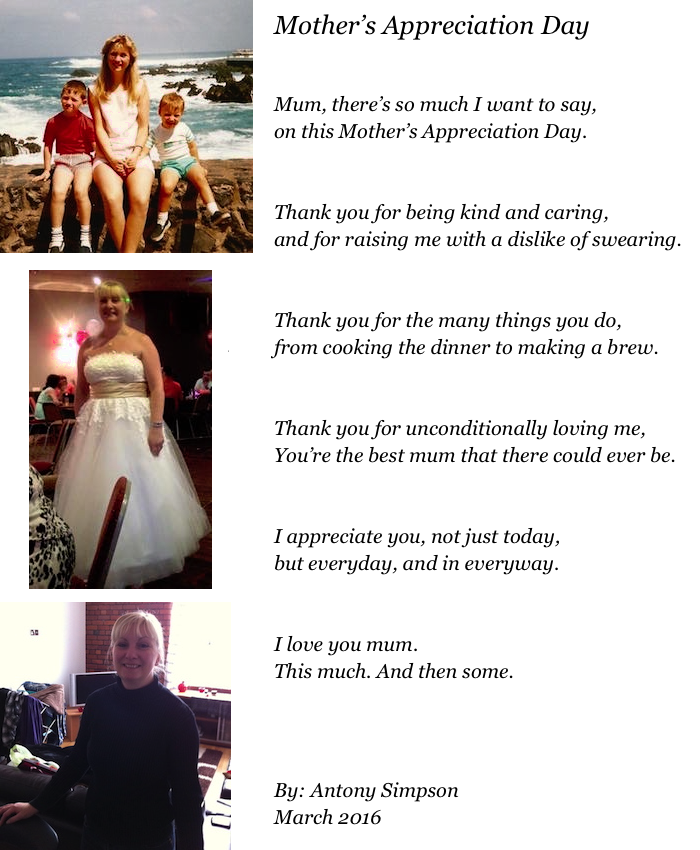 Inkwell & Quill. (Image Copyright: Sye Watts/Antony Simpson.) |
This is the third and final part in a blog post series, where I’ll be sharing some of what I’ve learned about creative writing over the last few years. The first blog post in the series was Creative Writing: Beginning and the second blog post in the series was Creative Writing: Middle.
1. Carry a Notebook for Ideas |
2. NEVER Delete Anything
Never delete anything that you write. Save everything. One day, you might want to go back to it. Even if you don’t continue where you left off, but instead start the creative work again with a completely different angle. You’re going to need the original beginnings.
3. Editing Checklist
Most writers spend more time editing than they do writing. It is advisable to click Save As… and save another version of your work with every edit, so that if you want to go back you can. Here’s my editing checklist:
![]() First Read Aloud. Any sentences that you struggle to read or make sense of usually need further work.
First Read Aloud. Any sentences that you struggle to read or make sense of usually need further work.
![]() Check for appropriate use of capitalisation, commas, semicolons, full stops and speech marks.
Check for appropriate use of capitalisation, commas, semicolons, full stops and speech marks.
![]() Check for typos.
Check for typos.
![]() Grammar and Spelling Check.
Grammar and Spelling Check.
![]() Cut Overwriting & Repetitions.
Cut Overwriting & Repetitions.
![]() Re-write sentences that don’t make sense or are unclear.
Re-write sentences that don’t make sense or are unclear.
![]() Second Read Aloud. Any sentences that you struggle to read or make sense of usually need further work.
Second Read Aloud. Any sentences that you struggle to read or make sense of usually need further work.
![]() Consistency Checks: Tense, Perspective, Description, Characters and Plot.
Consistency Checks: Tense, Perspective, Description, Characters and Plot.
![]() Consider plot and pacing. Are there any plot holes? Is the pacing of scenes, chapters or even the whole work to slow, to fast or about right?
Consider plot and pacing. Are there any plot holes? Is the pacing of scenes, chapters or even the whole work to slow, to fast or about right?
![]() Third Read Aloud. Any sentences that you struggle to read or make sense of usually need further work.
Third Read Aloud. Any sentences that you struggle to read or make sense of usually need further work.
![]() Put the work away for a few weeks, then go back to it and start the editing checklist again. A break from a creative project gives you distance and allows you to spot mistakes or problems that you didn’t see in the original writing or editing stages because you were to close to the work.
Put the work away for a few weeks, then go back to it and start the editing checklist again. A break from a creative project gives you distance and allows you to spot mistakes or problems that you didn’t see in the original writing or editing stages because you were to close to the work.
Here is another more technical editing checklist: Grammar Girl’s Editing Checklist.
4. Reader Feedback
Reader feedback is great. But you have to be open to any constructive criticism about your creative work. If you ask friends or family to read your work, ensure that you have a relationship with them that allows complete honesty. Ensure that this honesty doesn’t damage your relationship. I read a good friend’s creative work on a regular basis, as he does mine, and we are completely honest in our feedback. We can do this because we both know that the feedback we give and receive is given with kindness, and is aimed at helping one another to create the best work that we can.
You should always appreciate and appraise reader feedback from any source. Appreciate that someone has taken the time to read your work and give feedback. People who give feedback are often working on their own creative projects. They have taken time out of their creative work to give you feedback on yours.
You don’t need to agree on all the points that they raise, or change everything that they suggest needs changing. You are the creator of your own work, so use your own judgement. But consider the feedback, especially if you are getting the same feedback from several different sources.
Some Writers come together in local Writers groups to get feedback on their creative work. These days there are probably some Writers groups online. Some Writers find these groups useful, others don’t. The best way to see if this works for you is to give it a try.
5. Publishing Options
You can send your work to agents and publishers. To the larger presses or smaller independent ones. You can self-publish on Amazon and even get your self-published printed on demand (POD). I don’t have loads of knowledge about publishing or the experience to advise. All I would say is people with little or no experience manage to get their work published all the time.
6. Promoting Your Work
Some great ways to promote your work include:
- Get a good book cover designed. Book covers are the first thing people see about your work. A good book cover design can make the difference between people buying your creative work or not.
- If you’re writing the blurb on the back cover, make sure it is written in a way that sells your creative work.
- Use social media. Facebook, Twitter, goodreads and Instagram as a minimum.
- Approach appropriate bloggers, vbloggers and ask them to read & review your creative work.
- Send copies of your work to appropriate News Paper Entertainment Columnist, Magazine Writers, other Authors, etc. requesting they read & review your work.
- Attend literacy events and be involved with the literacy community (both locally and online).
- Do interviews with anyone that is willing to interview you.
- Try and be in the Media: TV, Radio, News Papers & Magazines. Even if it isn’t directly about your creative work, you’d be surprised how many people will see, hear or read what you say/write and go on to seek out your creative works.
- Do readings.
- Contact local libraries, book stores, etc and arrange signings and/or readings.
- Encourage people to write Amazon Reviews.
- Have a book Giveaway – people love the opportunity to win something.
- Hire a Marketing Company, there are many out there that specialise in the PR and marketing of books.
7. Some Great Books About Creative Writing & Publishing
Write soon,
Antony
| This is the second part in a blog post series, where I’ll be sharing some of what I’ve learned about creative writing over the last few years. The first blog post in the series was Creative Writing: Beginning.
1. Remember Your Aim 2. Your Writers Voice |
Some writers try to emulate the voice of writers that they admire. This can be an interesting exercise and way to explore how those writers show their distinctive voice. To get the most out of this exercise, rather than passively read, you need to analyse how they crafted their voice.
Author Elizabeth Gilbert whom has written of many books, developed her writers voice by writing each of her books to friend or family member. Her writers voice in Big Magic, a book about living creatively, is warm, caring, passionate, engaging and captivating throughout.
Your unique writers voice will generally develop over time, with regular writing practice. The key point here is: practice.
Simple Writing – Writer’s Voice: What it is and how to develop yours is a good article to read, where the author writes about phrasing, tone, attitude and gives some tips on how to develop your writers voice. But nothing really beats writing lots.
3. Keep Going
Don’t let fear hold you back from starting, continuing or finishing a piece of creative writing. Even if, as your writing, you think it’s the worst thing ever written, keep going.
As author Anne Rice says in this video, ‘Just kick out the pages:’
So keep writing, everyday if possible. Don’t be hard on yourself if you can’t manage everyday. Just write when you can. Whatever time you are managing to write, it’s better than not writing at all. Remember that if you keep going, eventually you’re going to finish. You’ll be bringing a new story into the world, which is wonderful.
4. Dialogue
Some rules generally apply:
- Less is more.
- Most people don’t talk to themselves. So don’t have characters do it.
- It should be a conversation, not a monologue or full of large longwinded statements.
- Don’t have a character explain to another character what happened in the last scene you wrote. It feels repetitive and tedious to the reader. One character can summarise to another character if absolutely necessary. But if the other character needs to know the details, then maybe he/she should have been in the last scene as a witness to events.
- Only on rare occasions should you cut the end of dialogue, like this: –. If you do it all the time, the dialogue isn’t moving the story along and the reader will get frustrated that no character ever finishes a sentence. Plus regularly cutting the end of sentences will lose its value and significance.
- Dialogue tags such as he said and she replied are useful to identify who is talking and how they are saying what they are saying. But the overall tone of the conversation should be clear from the words in the dialogue.
To improve your dialogue listen to the conversations of strangers in every public place that you visit. The dialogue you write should sound like that. It should have hooks. During the editing process, which I will write about in the next blog post in the series, it is useful to read it aloud to yourself or someone else.
5. Tense
Generally past or present tense is used. Future tense is rarely used. Once you’ve decided which tense to use, be consistent and use it throughout your creative work. Here’s an article that explains tense simply: Creative Writing – Tense.
6. Description
General fiction set in the real world needs less description than creative works set in other worlds. If your creative work is set in the past, future or another world consider: societal structures, culture, religion/belief systems, etc. Only tell the reader what they need to know.
Avoid writing cliché opportunities to describe a character or settings. One such example of a cliché opportunity is the main character standing in front of a mirror observing and describing themselves to the reader. It’s been done so many times, that it has become a cliché.
A good tip, when it comes to description is to make references. So for example, rather than writing: Jean drove off in her red car. Write: Jean drove off in her red Nissan Micra. Be aware that over time these descriptive references might date your creative work. Some descriptive references are so embedded into society that they could never date your creative work.
In my short story A Few Amazing Moments I deliberately used descriptive references to set the time in recent history that the various scenes were set in.
Perspective alters how you describe things. You can read more about perspective here. Pacing alters the amount of description a scene has. You can read more about pacing here. But the rule is: in slower scenes more description is allowed. In action or fast-paced scenes there should be less description. To much description or to little can significantly impact on your overall pacing.
7. Back-up Your Creative Work – Regularly
We’ve all heard nightmare stories about writers whom have lots their entire work because of a computer crash or computer dying on them. They either didn’t hit the save button or didn’t back-up their computer or both. I’ve lost large chunks of scenes in the past because I didn’t hit the save button often enought. I’ve also lost entire creative projects because a computer decided to die on me. So here’s the advice:
- Hit the save button at the end of every paragraph.
- Back-Up your work regularly. Some people use the cloud. I personally use Time Machine and then do a manual copy/paste back-up on an external hard drive once a week.
8. Done Is Better Than Good
This advice comes from Author Elizabeth Gilbert. In her book Big Magic, which have reviewed here, she writes about the danger of perfectionism.
If you aim for your creative work to be perfect you will drive yourself insane. No matter how much time, energy, effort and work you put into a creative work it will never be perfect. So rather than striving for perfection, aim for completing your creative work to the best of your current ability.
So many creative people, leave work in their desk draws, unfinished, because they don’t feel it’s good enough. Because they are aiming for perfection. Just take a second to imagine the number of superb stories that never see the light of day, let alone get read, because the writer is aiming for perfection.
9. First Draft
Congratulations on completion of the first draft of your creative work. But for a good writer, it’s not even half finished yet. The manuscript now needs to be edited, which may include some re-writing.
In my next blog post of the series, I’ll be writing about editing (including an editing checklist), feedback and publishing options.
Write soon,
Antony



